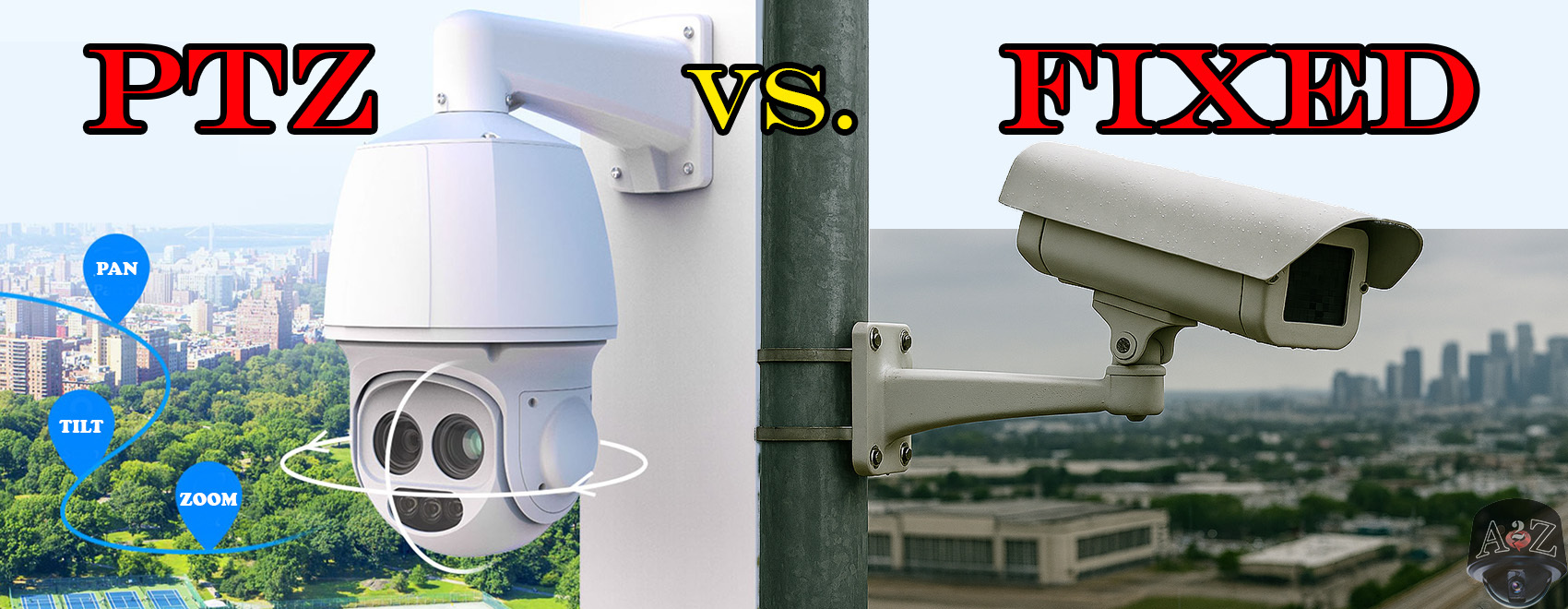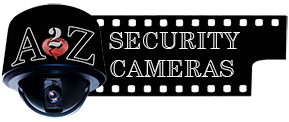PTZ vs. Fixed Cameras – Choosing the Right Coverage Strategy

By Justin C., Video Security System Specialist — A2Z Security Cameras
Introduction
When designing a surveillance system, choosing between PTZ (Pan-Tilt-Zoom) cameras and fixed cameras is a decision that directly affects capabilities, cost, and long-term functionality. PTZ cameras can mechanically pan, tilt, and zoom to track or enhance coverage of specific activity, allowing operators — or automated systems — to actively manage large areas. In contrast, fixed cameras provide continuous coverage of a set scene.
Both types have evolved significantly. Today’s PTZs come in multiple forms — dome, bullet, hanging, mobile-grade, explosion-proof — and often include advanced tools such as auto-tracking, integrated audio, or visible deterrent lighting. Meanwhile, fixed cameras have expanded far beyond simple static domes or bullets, with options like ultra-high-resolution sensors, panoramic/multi-sensor arrays, and built-in AI analytics. The right choice depends on your site layout, risk profile, monitoring style, and budget — and in many cases, the strongest strategy is a thoughtful combination of the two.
What is a PTZ Camera?
PTZ cameras are motorized devices that allow remote or automated movement: - Pan: Rotate horizontally (often 0–360° continuous rotation)
- Tilt: Move vertically (often ±90° or more)
- Zoom: Optical zoom to magnify details without quality loss (often 20×–40× in professional models)
Key Advantages: - Wide-area coverage with fewer units
- Ability to zoom in for identification, object tracking, or evidence gathering
- Preset tours, patterns, and event-triggered tracking
- Powerful tool in actively monitored or managed systems
Limitations: - Records only the area it’s currently aimed at — incidents outside its view may be missed
- Moving parts increase mechanical wear and maintenance needs
- Higher purchase cost compared to most fixed cameras
- Most effective in actively monitored or event-driven systems, less so as a “set and forget” solution
What is a Fixed Camera?
Fixed cameras maintain a static field of view — always recording the same scene. They include bullet, dome, and turret designs as the most common forms, but also extend to varifocal, motorized zoom, panoramic multi-sensor models and beyond.
The “fixed” label simply means the camera does not move dynamically after installation. Some high-end professional dome models allow remote roll, pan, tilt, or zoom adjustments for setup and calibration, but these are limited functions — not designed for continuous repositioning like a PTZ.
Key Advantages: - Continuous coverage — never “looks away” from the monitored area
- Lower cost and simpler installation compared to PTZs
- No moving parts, making them more durable with less frequent servicing
- Ideal for “set-and-forget” coverage of critical points
Limitations: - Cannot change view without manual repositioning
- Long-distance coverage is limited compared to true PTZ optical zoom
Side-by-Side Comparison
| Feature | PTZ Cameras | Fixed Cameras |
|---|---|---|
| Coverage | Adjustable; can pan/tilt to cover large areas | Static; covers a fixed scene |
| Detail Capture | High — optical zoom for fine detail | Medium — limited by lens & resolution |
| Best Use Case | Actively monitored or dynamic environments | Continuous coverage of key zones |
| Cost | Higher per unit | Lower per unit |
| Maintenance | Higher — moving parts, calibration | Lower — minimal mechanical wear |
| Missed Events Risk | Possible if looking away from incident | Low — always recording the set view |
| Operator Required? | Works best with monitoring or analytics triggers | No — records without intervention |
Key Factors to Consider
1. Coverage Style
- PTZ: Excellent for sweeping large spaces, covering multiple points of interest, or following moving subjects.
- Fixed: Best for entrances, chokepoints, and high-risk areas where uninterrupted monitoring is essential.
2. Detail & Identification
- PTZ optical zoom enables capturing evidence such as faces or license plates from long distances.
- Fixed cameras with higher resolution (4MP, 8MP, 12MP, or multi-sensor) provide detail across a wide scene but remain static.
3. Reliability & Durability
- PTZs involve moving parts, which may wear faster in high-use or harsh environments.
- Fixed cameras are simpler and often more rugged, with fewer points of failure.
4. Lighting & Environment
- PTZs often feature long-range IR or laser illumination, but performance can vary with weather and rapid scene changes.
- Fixed cameras can be optimized for specific lighting conditions — e.g., WDR at entrances, IR domes in alleys, or panoramic cameras for wide coverage.
Real-World Deployment Examples
Large Parking Lot / Storage Yard
- Fixed cameras at all entrances/exits for guaranteed vehicle capture.
- PTZs on rooftops or poles for wide-area monitoring and zooming in on suspicious behavior.
School Campus
- Fixed cameras in hallways, entrances, and cafeterias for continuous recording.
- PTZs on rooftops for event monitoring, large outdoor areas, and emergency tracking.
Warehouse Facility
- Fixed cameras for aisles, loading docks, and access doors.
- PTZs in open bays for monitoring forklift traffic, staff safety, or incident response.
Public Space / City Surveillance
- PTZs at intersections or plazas for live monitoring and response.
- Fixed cameras covering hot spots or locations with high incident likelihood.
Combining PTZ & Fixed Cameras for Best Results
Professional system designers often recommend layered coverage:
- Fixed cameras provide uninterrupted coverage of key points.
- PTZs act as “eyes on demand” — scanning, zooming, and tracking events.
- AI analytics can link the two, with fixed-camera motion alerts automatically triggering PTZ movement.
This layered approach reduces blind spots, balances costs, and ensures critical events are both captured and closely monitored.
Deployment Ratios & Practical Mixes
How many PTZs versus fixed cameras should a site use? There’s no universal formula, but common design patterns can help guide decisions.
- Home or Private Properties: Most residential systems rely entirely on fixed cameras, since they’re cost-effective and provide constant coverage of doors, driveways, and backyards. PTZs are usually specialty add-ons — often just one or maybe two for larger estates or higher-end systems where sweeping coverage of a yard, driveway, or perimeter is valuable.
- Retail Store (small/medium): Fixed cameras dominate for entrances, POS, and aisles to ensure uninterrupted coverage. A single PTZ may be added for the parking lot or to give managers the ability to follow suspicious activity.
- Campus or Warehouse: Fixed units handle doorways, corridors, and storage zones, while PTZs are strategically placed to oversee large open areas, loading docks, or outdoor perimeters.
- City or Public Space: A balanced mix is common. Fixed cameras provide evidence-grade recording of hotspots, while PTZs give operators flexibility to track incidents across larger spaces like parks, intersections, or plazas.
The key is layered coverage: fixed cameras guarantee consistent recording of critical areas, while PTZs enhance situational awareness and responsiveness in dynamic spaces.
Cost & Infrastructure Considerations
- Installation: PTZs need stronger mounts, strategic positioning, and sometimes higher power delivery (PoE+, PoE++).
- Bandwidth & Storage: A PTZ recording in motion can generate heavier data loads compared to static fixed cameras.
- Control Systems: Ensure your NVR/VMS supports PTZ presets, tours, and analytics integration. Compatibility has improved (IP via ONVIF, HD-CCTV via TVI/CVI/AHD), but differences remain.
- Maintenance: PTZs with high usage may require servicing or replacement sooner than fixed cameras.
Staffing & Monitoring Impact
Camera choice isn’t just about hardware — it also affects how the system is operated day to day.
- PTZs work best in staffed environments where operators or security teams actively monitor live video and can direct cameras to follow incidents. They are powerful tools in manned command centers, city surveillance, campuses, or other large areas with dedicated security staff. PTZs also shine in specialized use cases — such as event monitoring, crowd control, or mobile surveillance — where dynamic coverage is essential.
- Fixed cameras are better for unmanned or lightly staffed systems since they always capture the same scene without operator input. They provide reliable “always-on” coverage of entrances, high-value assets, or zones with a higher probability of incidents.
- Automation bridges the gap — modern surveillance systems increasingly use automation, whether built into the camera itself or triggered by other devices. AI-powered video analytics and camera linkages can direct PTZs to respond to events automatically, combining the consistency of fixed coverage with the flexibility of PTZ response.
Expert Insights
- Don’t rely on one PTZ for total coverage — always pair with fixed views.
- Presets & automation maximize PTZ coverage but can impact longevity — check manufacturer warranty terms.
- Zoom specs matter — don’t rely on “25×” or “40×” claims; review field of view and DORI ratings for real performance.
- Role-specific use — PTZs excel when staff are monitoring; fixed cameras are better for unmanned systems.
- Not all models are equal — within both PTZ and fixed categories, build quality, optics, illumination, and analytics vary widely.
Future Trends in PTZ & Fixed Cameras available now!
- AI-assisted PTZ control — cameras that auto-track vehicles or people with minimal or zero operator input.
- Hybrid designs — multi-sensor fixed cameras integrated with PTZ modules for “best of both worlds.”
- Edge analytics — both PTZ and fixed models increasingly support onboard AI to reduce bandwidth, enhance detection capabilities plus improve efficiency and speed of alerts.
Conclusion
PTZ and fixed cameras each offer distinct strengths. PTZs provide flexibility, zoom, and dynamic coverage for wide areas or actively monitored environments, while fixed cameras deliver reliable, continuous recording of critical points.
Sometimes the decision is straightforward — fixed cameras for entrances, PTZs for large outdoor zones — but in many cases, the most effective systems use both. Fixed cameras ensure nothing is missed, while PTZs allow operators or analytics to investigate events in greater detail.
It’s also important to recognize that specialized environments — such as mobile surveillance, industrial sites, or high-security campuses — may benefit more from one class of camera over the other. Starting with an understanding of the core differences between PTZ and fixed designs makes it clearer when a certain feature set (e.g., powerful zoom, panoramic coverage, or always-on durability) will deliver the most value.
Ultimately, the right balance depends on your site layout, monitoring style, and long-term goals. By weighing these factors, you’ll be able to design a system that’s both effective today and adaptable for future needs.
Next Steps
- Read: Choosing the Right Resolution – 1080p, 4MP, 4K, and Beyond
- Read: Analog & HD CCTV vs. IP Cameras – Which is Right for You?
- Browse Catalog: IP Network Cameras
- Browse Catalog: CCTV Cameras
- Contact our design team to build a coverage strategy.
